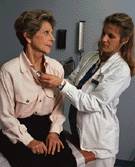
WEDNESDAY, Dec. 16 (HealthDay News) — In the first six months of this year, 45.4 million Americans of all ages — or 15.1 percent of the population — had no health insurance, according to new National Health Interview Survey statistics released Wednesday.
In addition, 58.4 million (19.4 percent) people of all ages had been uninsured for at least part of the year prior to the interview, and 31.9 million (10.6 percent) had been uninsured for more than a year at the time of interview, according to a report from the U.S. Centers for Disease Control and Prevention’s National Center for Health Statistics.
The findings are from data analyses of almost 32,700 respondents. NHIS data, collected since 1957, is widely used to monitor health trends.
Among the other results from January to June:
- The percentage of children under age 18 without insurance at the time of interview was 8.2 percent.
- Among adults up to 64 years old, 60.6 percent of those who were unemployed had been uninsured for at least part of the past year, and 21.8 percent of those who had jobs had gone without insurance. Also, 32.9 percent of unemployed adults and 13.3 percent of employed adults in this age group had been without insurance for more than one year.
- Among those under age 65 with private health insurance, 22.7 percent were enrolled in a high deductible health plan (HDHP), including 6.4 percent who were enrolled in a consumer-directed health plan (CDHP).
- Nearly 50 percent of those with a private plan obtained by means other than through an employer were in a HDHP, and about 20 percent of those with a private plan were in a family with a flexible spending account (FSA) for medical expenses.
- At the time of interview, 12.3 percent of poor children and 11.6 percent of near-poor children didn’t have insurance.
- The percentage of near-poor children who lacked insurance at the time of interview decreased from 15.6 percent in 2008 to 11.6 percent in the first six months of 2009.
- At the time of interview, 80.9 percent of poor children and 57.8 percent of near-poor children were covered by a public health plan.
- The increase in public coverage for near-poor children increased from 53.4 percent in 2008 to 57.8 percent in the first six months of 2009. This was not a significant increase, according to researchers.
- At the time of interview, 8.4 percent of poor children and 35.1 percent of near-poor children were covered by private health insurance. Between 2008 and the first six months of 2009, there was no significant change in private coverage for poor, near-poor and not-poor children.
- The percentage of near-poor adults younger than 65 who didn’t have insurance at the time of interview increased from 2008 to the first half of 2009.
- Lack of health insurance coverage was highest in the South and West.
More information
The U.S. Agency for Healthcare Research and Quality has more about health insurance.

